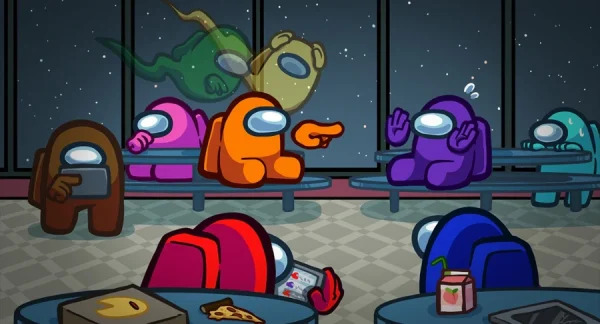Popular Now
Introduction
When Among Us exploded in popularity during 2020, it became known for its tense, minimalist approach to communication and deception. The game was designed to limit conversation to short, structured meetings, making every word and silence matter. However, the rise of third-party voice chat platforms like Discord changed the game—not just socially, but fundamentally. This article explores how voice chat impacts the core mechanics of Among Us, distorting gameplay, communication dynamics, and player strategy.
1. The Original Design Philosophy: Silence as a Weapon
At its core, Among Us thrives on strategic silence. The game restricts communication during actual gameplay, only allowing players to speak during emergency meetings or when a body is reported. This intentional silence forces players to think carefully, observe closely, and use limited information to decide who the Impostor is.
The tension builds as players are left with their thoughts, suspicions, and brief meetings to make life-or-death calls. This design ensures the game is balanced between deduction and deception, encouraging bluffing, storytelling, and logical reasoning.

2. The Rise of Discord Integration
As Among Us became more popular among friend groups and streamers, players naturally turned to Discord for smoother communication. But this broke one of the game's most important design rules—limited speech. Instead of only speaking during meetings, players began talking freely, before, during, and after tasks.
This constant communication stripped away the need for analysis or deduction. Players could clarify misunderstandings immediately or leak critical information unintentionally through a slip of the tongue or background noise. Discord made the game more social—but less strategic.
3. Real-Time Voice Equals Real-Time Meta Breaches
One of the biggest problems with third-party voice chat is that it allows real-time information to leak outside the boundaries of the game. A gasp during a kill, a background keyboard sound, or even a surprised laugh can give away the killer’s identity.
These "meta" cues, which come from outside the actual game mechanics, interfere with the intended experience. Instead of solving mysteries with logic, players begin reacting to sounds, emotions, or slips in conversation—something the original design tried to avoid.
4. The Death of the Dead: Ghost Chat Problems
In the game’s default settings, dead players can no longer speak to the living. This rule is essential—it prevents ghosts from giving away who the killer is. However, when using Discord, it’s hard to enforce silence, especially in casual games.
Sometimes dead players whisper tips, react emotionally, or simply forget to mute themselves, unintentionally giving clues to the survivors. Even if they don't speak, background reactions (like groaning or laughing) can affect decisions. The dead, who were meant to be passive observers, become ghostly influencers.

5. The Rise of House Rules and Honor Systems
To restore some balance, many communities introduced "house rules." These are informal guidelines such as muting yourself during gameplay, avoiding reactions if you're dead, or using separate Discord channels for ghosts.
While helpful, these systems rely entirely on players being disciplined and respectful. In public lobbies or less serious groups, these rules are often ignored, creating an inconsistent and often unfair game experience.
Common house rules include:
-
No talking while doing tasks.
-
Dead players must mute or leave the voice channel.
-
Avoid emotional sounds (gasps, laughter, sighs).
6. Twitch Culture and the Streamer Meta
As streamers began broadcasting Among Us regularly, the game’s culture shifted again. High-profile content creators embraced voice chat, added webcams, and encouraged constant talking for entertainment.
This changed the game from a slow-paced mystery to a fast-paced show. Loud accusations, reactions, and jokes dominated gameplay, while traditional strategy and deduction were sidelined. The streamer meta prioritized excitement and content creation over fairness and stealth.
7. Developer Response: Proximity Voice Chat
In response to the growing dominance of voice chat, modders created tools like CrewLink, which introduced proximity-based voice chat. This allowed players to talk only when near each other in the game, creating more natural interactions while keeping voice communication limited.
This system was a step forward—it preserved the tension of isolation while allowing social moments during gameplay. However, it still had issues like dead players not always muting properly, and technical problems with the software.
Benefits of proximity chat:
-
Adds realism to conversations.
-
Reduces full-lobby chaos.
-
Encourages spontaneous alliances or suspicion.
Drawbacks:
-
Harder to monitor ghost silence.
-
Occasional bugs and disconnections.

8. The Role of Mods in Rebalancing Gameplay
Besides proximity chat, modders also introduced custom roles like the Sheriff (can kill impostors) or Jester (wins if voted out). These additions gave players new objectives and blurred the black-and-white structure of "crewmates vs impostors."
These roles shifted focus away from pure logic and reduced the dominance of voice communication by offering more varied paths to victory. Players had to consider new behaviors and motivations, making the game more complex and harder to exploit with voice chat alone.
Examples:
-
Sheriff: Kills impostors but dies if wrong.
-
Jester: Tries to act suspicious and get voted out.
9. Cross-Platform Communication Imbalance
With Among Us becoming cross-platform, players on mobile, PC, and consoles often play together. But not all players have equal access to Discord or similar tools. Mobile and console players may struggle to type or join voice calls, while PC players with Discord can coordinate easily.
This creates unfair advantages. Some players communicate seamlessly, while others are left in the dark. The inconsistency frustrates newer players and hurts the overall experience, especially in public lobbies.
Issues include:
-
Slower typing speeds on mobile.
-
Lack of voice support on consoles.
-
Language barriers in global lobbies.
10. Finding a New Balance: The Future of Voice in Among Us
Today, Among Us developers are adding roles, cosmetics, and in-game features, but have not fully addressed the voice chat issue. The ideal future would include native voice chat with built-in controls, such as automatic muting for the dead and distance-based audio.
This would allow the game to retain its original strategy and tension, while embracing the social nature players now expect. Until then, players must rely on mods, house rules, or strict lobbies to preserve game balance.
The next evolution of Among Us must find a way to blend social fun with strategic fairness—because when everyone talks, no one listens to the silence anymore.
Conclusion
What once made Among Us brilliant was the fragile balance of limited communication and calculated silence. With the rise of third-party voice chat, that balance broke. Games became less about deduction and more about performance or emotion.
While voice chat adds a social dimension, it undermines the structure that makes Among Us unique. Developers and players must work together to create solutions—whether through proximity tools, in-game voice systems, or redesigned mechanics. If done right, the game can evolve without losing its core identity.

















